We’re always attached to our pets. Whether it’s a dog, cat, goldfish, or even something like a tree frog. And it’s always going to make us sad when we learn about their deaths. Since frogs don’t have a long lifespan, their demise is just natural.
But not all owners can cope with it at first. As a result, there are many frog owners who keep asking, “How come my tree frog died?” Some just want some closure, while others just want to know what more they could have done.
Whatever your reasons may be, I’m here to disclose information that you long for. If you go below, you’ll find some causes of tree frog deaths. So, keep reading to see how you can help your pet tree frog survive…
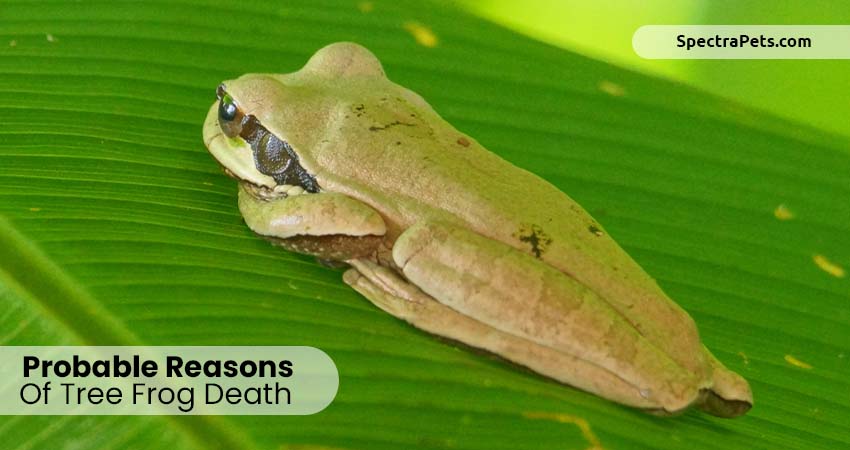
Probable Reasons Of Tree Frog Death
If you take proper care of your pet frog, it might live five to thirty years. But a lot of them don’t get to live that long for a variety of reasons.
Without the right habitat, a tree frog may die prematurely. Similarly, if you wait until your tree frogs are already sick, they may die. Uncoordinated tank changes could also kill your little friend. Other reasons for death include age, illness, and injury.
I’ve done some research and come up with a few possible explanations for the loss of your beloved tree frog. If you own a tree frog, it will be beneficial for you to be aware of these possible causes in order to safeguard your cute pet. Let’s take a quick look at each of the root reasons, shall we?
Now, I’m going to write out every possible reason in depth along with their remedies in order to educate you even more. We might probably chalk it up to these possible causes:
- Being aged
- Poor Husbandry
- Open wounds
- Got Infected
- Diseases
- Improper Handling
- Not being fed properly
- A Lack Of Adequate Nutrition
- The Substandard Quality Of The Water
- The Lack of Coordination Regarding Temperature
- An Inadequate Amount of Humidity
- Substrate
- An Absence Of Adequate Ventilation
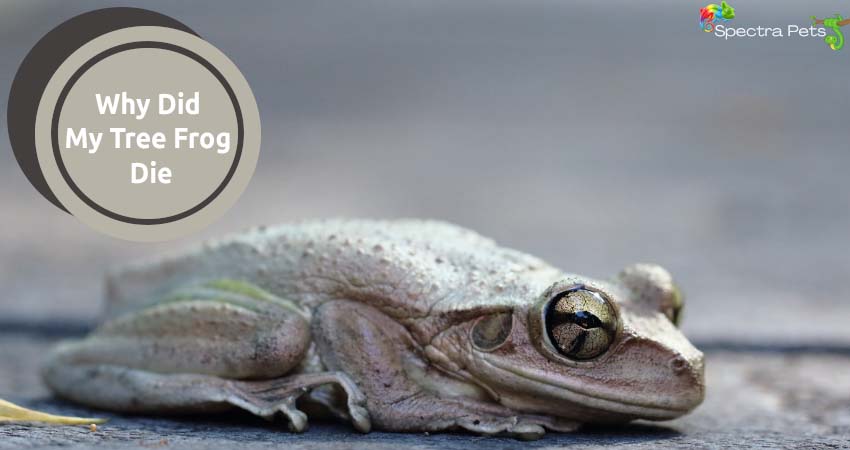
Probable Reasons & Solutions [If Possible]
Now that we’ve covered the short end, let’s dive into the details of the problem and the potential solutions:
1. Being aged
The death of your tree frog may be the result of its old age. These amphibians are no different from the rule that says all living things must die at some point. The harsh reality is that your beloved pet will have to die one day.
Tree frogs may live in captivity for up to 5–9 years. If the frog died after a lengthy period of companionship and showed no strange behavior, the frog may have died of old age.
2. Poor Husbandry
Tree frogs do not need very much care or attention. You do not have to go to the trouble of providing daily food for an adult frog. In addition to that, these frogs do not produce a significant amount of waste.
However, despite their reputation for being low-maintenance, frogs still need to be kept in good condition in order to function properly. It is possible for parasites, bacteria, germs, and other things to enter the terrarium if it is not cleaned regularly. In the end, they will poison your frog.
Multiple bacterial illnesses may be traced back to the unaltered and excessively wet substrate. Also, if you don’t change the water often enough, your frog could get sick from the bad quality of the water. You must be aware of the fact that edema is caused by drinking water of low quality.
Your frog might end up dying as a result of poor husbandry if you don’t take proper care of it.
Solutions
Every two weeks, you should give the terrarium a very thorough cleaning. In addition, you need to do daily spot cleaning of the frog feces, leftovers, and so on.
Check that the water, the substrate, and the decoration are all clean. Also, good maintenance means making sure that the humidity, lighting, temperature, and other factors stay within their best ranges.
3. Open wounds
Being arboreal, tree frogs may often scale vertical surfaces or hop from branch to branch. Because of this, there is a possibility that they may trip and get an injury.
On the contrary, when these frogs are moving about or playing, they run the risk of being injured by the decorations in the tank. The tree frog may suffer injuries as a result of an assault by another tree frog on occasion.
Therefore, infections will occur if the wounds or injuries do not heal in the normal course of events. If the illnesses continue to worsen, it is possible that your tree frog may pass away.
Solutions
You should follow the suggestions that are given below to prevent your lovely amphibians from becoming injured or dying.
- The terrarium for the tree frogs should not be overcrowded.
- Tree frogs’ delicate skin can’t take the roughness of artificial grass or gravel, so keep them away from such surfaces.
- Check to ensure that the decorations you’re using won’t harm the tree frogs you keep.
In addition to this, you need to check to see whether the illness brought on by the tree frog is getting any worse or not. Taking an injured frog to the vet as soon as possible is highly recommended.
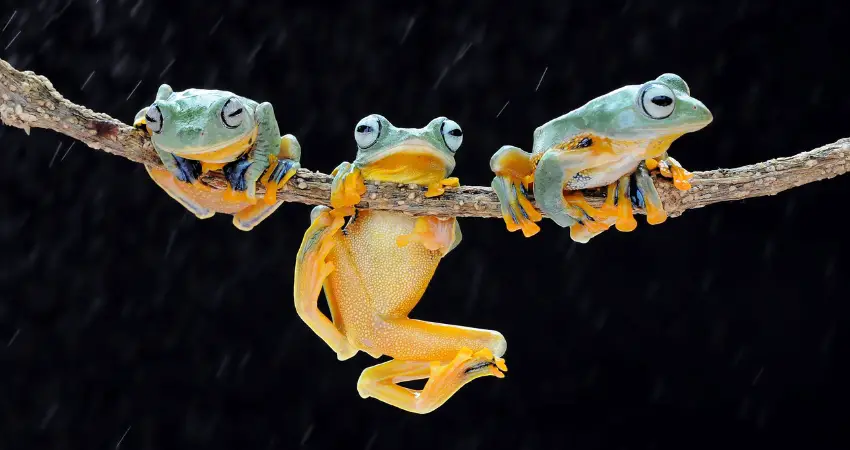
4. Might Get Infected Before You Buy
Sometimes, many people who own tree frogs are shocked to discover that their pets pass away only a few days after they bring them home. It is possible that you are not to blame for this situation if the habitat was not set up in an inconsistent manner. Possibly the tree frog you bought had an illness before you bought it.
In this regard, it is possible that these frogs will not make it through the night regardless of how closely you monitor it.
Solutions
Before making the purchase, you need to determine whether or not the frog is in good physical condition so that you can prevent unfortunate outcomes like this.
You are able to examine the tree frog to see whether or not its eyes are clouded. This is due to the fact that clouded eyes are a telltale symptom of an unhealthy tree frog.
Conduct a careful inspection to see if the tree frog you have picked has any injuries, strange markings, or other anomalies. A tree frog might develop an infection as a result of these accidents, which could eventually lead to death.
Last but not least, if you keep numerous tree frogs together, you need to isolate the newly acquired tree frog in a quarantine area. In such a case, there is a possibility that illnesses will be distributed more widely if the new tree frog contains any sickness.
5. Diseases
It is no surprise that tree frogs have a weakened immune system from illnesses. Because of these illnesses, your sweet friend will not live as long as they should.
Moreover, these diseases may be caused by a variety of pathogens, including bacteria, fungus, viruses, and others. Inadequate nutrition may also play a role in the development of some sicknesses. Inadequate maintenance and upkeep might be the source of some of these problems as well.
Let’s learn more about the illnesses that tree frogs might suffer from, shall we? These conditions include edema, metabolic bone diseases, redleg, impaction, dropsy, spring illness, impaction, diseases caused by parasites, and bacterial infections. Edema is one of the conditions.
It’s possible that one of these illnesses took the life of your beloved tree frog, but it may have been another.
Solutions
You need to get the expert assistance of a veterinarian no matter what ailments you think you could be experiencing. Do not give the tree frog any medication without first consulting with a professional vet.
Take preventative measures as soon as possible to protect your frogs from this pathetic condition.
To protect against illnesses caused by germs, you need to get rid of all of the decorations, filters, substrates, and so on. After that, you need to sanitize the whole aquarium and disinfect every piece of furnishings. Remember to give all of the items a thorough washing with fresh water.
Maintaining a high standard of husbandry is absolutely necessary if you want to avoid your pet tree frog getting certain diseases. In addition to that, you should be sure to stick to a healthy diet and take the appropriate vitamins and minerals.
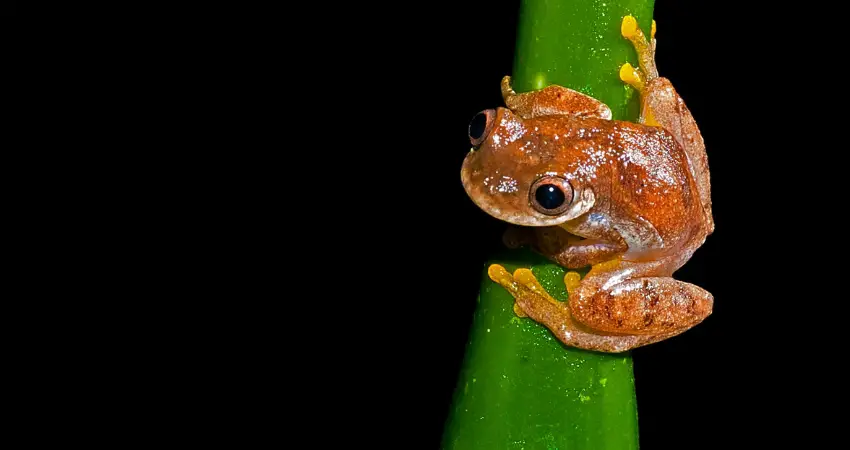
6. Improper Handling
Have you ever considered that touching your dogs may result in their death? In the case of other frogs, this may be rare. However, tree frogs may die if they are mishandled.
When it comes to human interaction, tree frogs are particularly sensitive. You should not keep the tree frogs unless there is any urgency.
You may be aware that the skin of these frogs is soft and absorbent. Handling them without thoroughly cleansing your hands is dangerous.
Their skin may absorb hazardous chemicals, oil, soap, and other substances from your hands. Due to this, such carelessness may end in their death. Squeezing the tree frog by accident might also be fatal. As a result, your frog will die unexpectedly.
Improper handling may have been the cause of your tree frog’s death, which you may be worried about.
Solutions
First and foremost, you should avoid handling tree frogs unless absolutely essential. Wear latex gloves if you need to hold tree frogs. Don’t forget to get the gloves a little moist as well. This will help the tree frogs feel at ease.
7. Improper Feeding
In addition to other problems, incorrect feeding might lead to the death of your pet tree frog. It’s possible that you wouldn’t have thought that feeding your tree frog in an improper manner may be the cause of its death.
But, certain foods are banned for household tree frogs. For example, petfoods, processed foods, insects that have died, human food, wild-caught insects, fruits, comparatively larger live prey, vegetation, and commercial pellets.
Sometimes intaking foods can end your cute pet life. If your friend is already dead you should check out the list of food that it takes before its last breath. And if you find any of the mentioned food in your list you should take a serious account of it.
Inadequate or excessive food intake is another factor that may kill your friend. If you feed your pet excessively, they will get morbidly obese and have other health problems. A fat tree frog isn’t agile enough to hunt, play, or do other things.
As a result, the frog stops moving around and gets heavier. It will have an effect on its entire body. So, overfeeding might shorten your pet life.
However, tree frogs may get ill if they are not fed in proper portions. Consequently, it can lead your pet to its deathbed.
But you really shouldn’t let your pets die of starvation for no good reason at all. You may reduce the temperature of your tree frog’s tank if you won’t be able to feed it for an extended period of time. Because of this, the individual’s metabolism will be significantly slowed down.
Solution
Improper feeding can sometimes result in the death of your adorable pet tree frog. You have to make sure that you are not providing any food item that could harm them. It is necessary for the live prey to fit into the frog’s mouth. For that reason, they have to be small enough.
As a sign of affection, some pet owners overfeed their pet frog. However, you should not do so. because your cute pet might die from overfeeding.
However, you must stick to a certain feeding schedule in order to properly feed your adorable cute friend.
When they are between 3 and 4 weeks old, baby tree frog tadpoles typically need to eat once a day (regularly).
Meanwhile, baby tree frogs that are becoming older need to eat numerous times throughout the day. In the case of young tree frogs, you need to provide food on a regular basis in very small amounts. However, mature tree frogs only need food two to three times each week, or once every other day, in order to thrive.
8. Nutritional Deficiencies
Tree frogs are vulnerable to diseases brought on by malnutrition, and if yours becomes sick enough, it might die. A rich diet full of vitamins and necessary nutrients will help them a lot.
If by any chance, the frogs are denied their necessary nourishment, there is a chance they’ll get affected with life threatening diseases. These include various vitamin deficiency (for example, vitamin A) bone disease, redleg, etc.
Alongsides diseases, lack of nutrition also makes your frog lethargic. On top of that, it will throw the body’s immunological system into chaos. As a result, they are prone to viral diseases as well as infection from pathogens.
Therefore, their life expectancy will be reduced because of their compromised immune systems. Your pet could die as a consequence.
Solutions
You should provide them with different kinds of insects to eat. Also, you should give your frog treats once a week and once a month. Remember, half-dead prey should be avoided. Make sure they are hydrated.
Additionally, You must dust the food 1-2 days prior to feeding. Moreover, You should add calcium supplements to their diet everyday.
Lastly, if the food lacks vitamins, add them via supplements. You also need to monitor whether or not the supplement affects the health of the frog.
9. The Substandard Quality Of The Water
Most tree frog owners are unclear about the type of water they should provide for their pets. Another factor contributing to the decline in the health of tree frogs is the regularity with which the water is changed. Not to mention the fact that these variables create a variety of diseases that could possibly result in certain death.
A surprising factor that might have contributed to your tree frog’s death is the use of tap water. Yes, the water that comes out of the tap often includes a number of toxic chemical components, such as chlorine, ammonia, and heavy metals. So, tree frogs should stay away from such water.
In addition, since the tree frogs play in the water and defecate in it, the water has a tendency to get polluted. So, undoubtedly, the lack of frequent water changes will have a negative impact on their health and might put their lives at risk.
In addition, many frog keepers overlook the importance of spraying the tank with water from the faucet. Tree frogs not only consume the oxygen that is present in the water with which they come into contact, but they also consume the poisons that are present in the tap water, which they use to wash their hands. It may result in an unusual death for your pet frog.
Solutions
Never, under any circumstances, give tree frogs water from the tap. In the absence of an alternative, you may use tap water after dechlorination. If you are unable to dechlorinate the tap water, you may let the water sit out for twenty-four to forty-eight hours before feeding it to your tree frog. Since the chlorine will have evaporated, it will be safe to do so.
When caring for tree frogs, some authorities recommend utilizing spring or bottled water. Your pet frog won’t get sick from drinking water like this.
Check to verify that the water you have given does not contain any ammonia, nitrate, or other contaminants. In addition to that, you need to keep the water dish clean and constantly replace the water in it.
10. The Lack of Coordination Regarding Temperature
There is no question that tree frogs, like all other frogs, are cold-blooded. Therefore, the temperature of the habitat in which tree frogs live must remain stable.
Temperatures between 75 and 85-degree F during the day and 65 and 75-degree F during the night are suitable for tree frogs. You must be aware that tree frogs are able to thrive in environments with typical room temperatures.
But in cold regions, the temperature of the room you’re in might not be optimal for your frog. So, in such conditions, your lovely pets will have a hard time maintaining ideal body temperature without some source of heat.
In addition, some frogs can’t withstand temperatures below 0 °C (60-degree F). Therefore, the decreased temperature may be another factor in the death of the frogs.
Additionally, if the temperature is higher than the optimal range, it might cause stress in the frogs. It has the potential to have a devastating impact on their health. It’s possible that your little friend may pass away due to unbearable stress.
Solutions
The most effective method for maintaining a consistent temperature involves creating the tank such that it has both a cool & a warm end. If this is the case, you need to watch out for maintaining the highest and lowest temperatures at the appropriate levels of heat and cold, correspondingly.
Because of this, your frog may go to one or more of these areas, depending on how much heat it needs.
It’s recommended that you put a heat light or basking lamp on the terrarium’s ceiling. However, keep the heat light away from the lid at all costs. In the event that a tree frog unintentionally comes into contact with the heated surface, the animal will perish as a result of its injuries and the subsequent infections.
When it comes to maintaining a comfortable temperature inside the enclosure, some frog keepers like using a heat pad. Make sure, however, that you do not lay the mat on top of anything that may catch fire.
Again, in the event that the tank for the frog is made of plastic, placing the heat pad in close contact or near the enclosuse poses the risk of an accident occurring. In this kind of situation, your adorable tree frog might end up dying.
You may use a heating element (thermostat-controlled) to maintain an ideal, constant, comfortable temperature.
11. An Inadequate Amount of Humidity
A lack of humidity may have also contributed to the death of the tree frog. Frogs are mostly found in wet environments in the wild. Therefore, you will also need to ensure that the captive habitat is moist enough.
Tree frogs’ ideal humidity range is between 60 and 80 percent. The survival of tree frogs will be at risk when humidity drops below 50 percent.
Perhaps you already know that these amphibians use their skin as a respiratory system. As a result, having the right amount of moisture around them enables them to better absorb oxygen since it keeps their skin wet.
When the relative humidity becomes less than 60 percent in captivity, these guys’ skin becomes dry. Your tree frogs may not be able to take in oxygen as a direct consequence of this. Your friend will pass away at some point.
In addition to this, the tank’s high degree of humidity is another potential cause of mortality for the tree frogs. Even if the humidity reaches a level of 100%, it is expected to return to a level of between 60% and 70% once some time has passed.
Solutions
It is recommended that the terrarium be misted once or twice every day to prevent the skin of tree frogs from becoming dry. In addition to this, maintain a substrate that has a tiny amount of moisture in it so that your frog can stay wet. You might also keep a container of water that has been filtered to remove the chlorine.
It is recommended that a hygrometer be maintained in the terrarium in order to keep track of the relative humidity. In contrast, you should invest in a top-notch digital hygrometer since these instruments are notorious for providing reliable readings.
12. Substrate
It is hard to believe, but tree frogs can die due to the substrate inside the enclosure. However, this fundamental aspect of these tree frogs’ habitats has the potential to bring about such a heart-breaking occurrence.
It is necessary for the substrate to remain moist in order to retain humidity; however, it should not become soggy or waterlogged. A moist ground, specifically one that drips water, has the potential to produce illnesses in tree frogs that are caused by bacteria.
In addition, there have been instances in which tree frogs have been adversely affected as a result of their incorrect consumption of gravel.
Solutions
Make use of a substrate that is similar to mulch and can take in the maximum quantity of moisture. Therefore, you have the option of using substrates such as sphagnum moss, coconut fiber, or coconut husk.
In addition to this, you need to ensure the substrate isn’t soaking wet with water.
Regular spot cleaning of the substrate is something that can be done. Additionally, you need to give the substrate a thorough cleaning once per week. You should replace the substrate after using it for 2 years. There are some substrates that need to be changed even more frequently.
13. An Absence Of Adequate Ventilation
A comprehensive habitat for tree frogs must include a ventilation system in order to keep the environment healthy. The air within the tank will eventually turn stagnant unless there is no means for it to be ventilated. Therefore, tree frogs will have a difficult time thriving in such a densely forested habitat.
As a direct consequence of this, your beautiful tree frog will get anxious. Not to mention the fact that this might result in the tree frog you have dying in an odd manner.
Solutions
Increasing ventilation is the only possible way to prevent a situation like this from occurring. In addition to this, you have to take into consideration that these tiny creatures have a tendency to jump out of their terrariums. Therefore, you need to ensure that the ventilation system is set up correctly so that the frog is unable to escape.

Signs A Tree Frog Is Dying
The following are some obvious signs that a pet frog may be nearing the end of its life:
- Their skin has a discolored appearance.
- Ulcers, often known as open sores, may be found everywhere on the body of the frog.
- There is a possibility of bleeding. It gives the impression of being very sluggish.
- They seem to be confused at times.
- Their limbs start to disintegrate one by one.
- They quit taking in any food.
- There is a possibility of either a sudden or progressive loss of weight.
- Lacking in sloughing (cleaning and eating its dead skin).
Is Your Pet Frog Dying? What to Do?
Pet tree frogs die because of infections, diseases, and abnormalities. If the circumstances that your frog is in are due to its surroundings, there is still a chance that you can rescue it.
The environment in which pet frogs are kept has a significant impact on their health. It is possible that your cute amphibian may get ill if one of the circumstances is stressful rather than optimum.
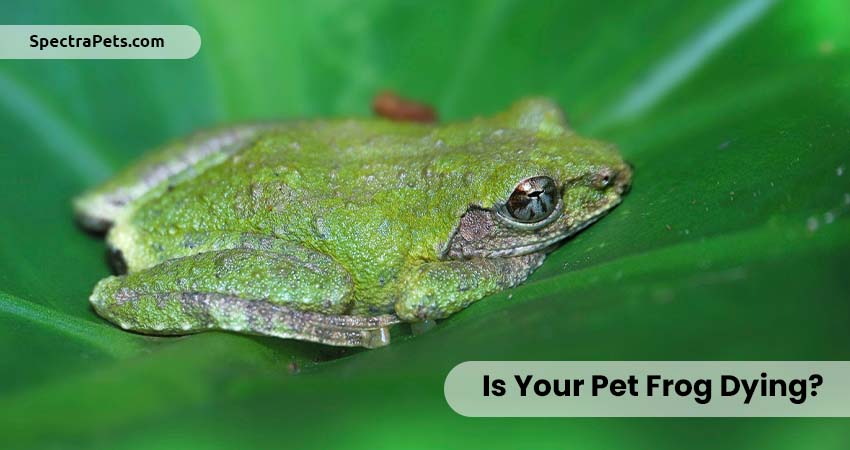
You want to examine the living circumstances of your pets and make certain that everything is proper for them. The health of your pet tree frog may often be improved by making adjustments to the environment in which it lives.
It’s horrible to find out that your pet tree frog is dying. But, by making haste, you can save your friend’s life.
The first step is to recognize any signs or out-of-character actions from your pet tree frogs. Such as swollen limbs,discoloration, cloudy eyes, lethargy, inability to eat, etc. Look for any injuries or open wounds. I recommend that you first discuss the matter with a licensed veterinarian who is located in your region.
The presence of one or more of these symptoms indicates that your tree frog may be sick. In addition to this, you need to examine the frog to see whether it has any cuts or scrapes. If he is having symptoms that you have the ability to influence, you should also make an effort to ameliorate his physical circumstances as they now stand.
You should not put off visiting a veterinarian after spotting signs of this kind. Never give a drug to an animal without first discussing it with a professional vet.
Then, carefully adhere to the veterinarian’s recommendations and provide essential medical care for your beloved tree frog. You may bring your sick tree frog back to life if you provide it with the medicine and attention it needs.
Signs A Pet Frog Is Dead
The following are some symptoms that may indicate that a pet frog has passed away:
- The eyes are closed, and there is no movement in the respiration.
- Color is fading or they starts to become white.
- If stopped moving for a considerable amount of time.
- The arms and legs are splayed out over the surface of the earth. They are resting on their backs with their bellies facing upward.
- They both have their tongues sticking out of the sides of their lips.
- Give off a rotten odor all by themselves.
- Infested with flies or maggots.
Could It Be That My Frog Is Hibernating?
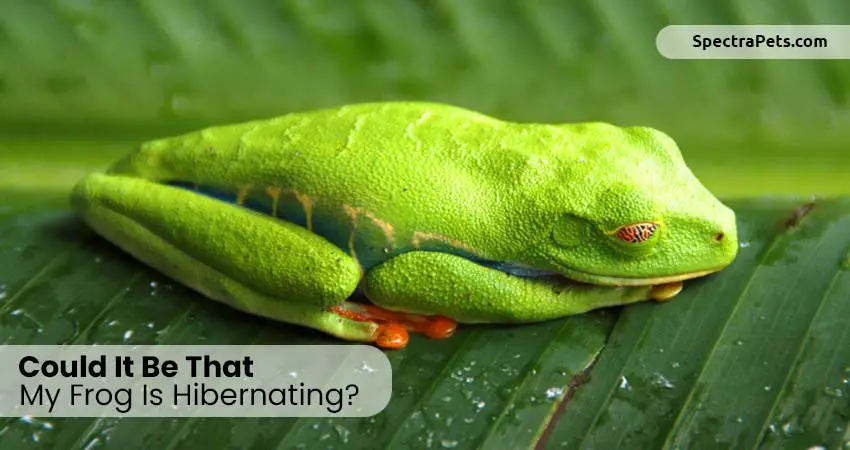
Tree frogs may get effectively frozen solid like dead throughout the winter months.
Tree frogs can go into a state of dormancy where they look like they are dead. Tree frogs can get partially frozen in winter due to their cold blood. So, this is a pretty common thing to happen if you think your cute friend is dead when it is hibernating.
When it gets freezing, tree frogs go into hibernation and wake up when it warms up again. As a result, it might be difficult to tell whether your pet frog has passed away or is just hibernating.
A Frog Has Died: What to Do With It?
If your frog dies, don’t put it in the toilet or release it outside. Although this is common practice, it puts you at risk of spreading sickness to other animals if you do it.
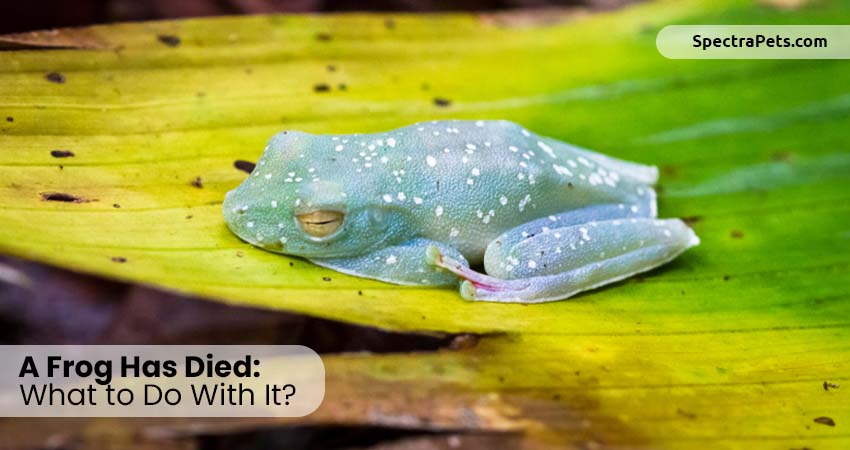
If your tiny friend passed away, you have a few options for what to do with its corpse, which is as follows:
- Put the frog’s body in a shoebox and bury it in your garden. Then, have a little ceremony in its honor.
- Put the frog in the trash after wrapping it in a paper towel and putting it there.
- Take your pet tree frog in to the veterinarian so that they may dispose of it in the appropriate manner.
- If your frog was healthy, you may take it to a taxidermist to have it preserved.
Make sure not to dispose of it by flushing it down the toilet or throwing it out in an uncontrolled environment.
How to Prolong the Life of a Pet Tree Frog?
Sadly, the habitat that the owner creates for their pet tree frogs is one of the primary contributors to the majority of the causes of death for these amphibians.
Premature death in a pet frog may be caused by a number of factors, including an inadequate substrate, lighting, or heating system; an inadequate quantity of humidity; water; or a deficiency of vitamins and minerals.
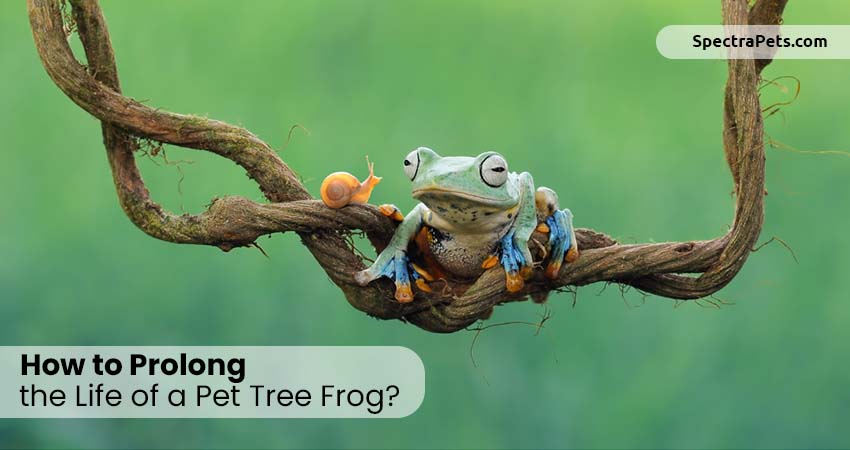
Therefore, in order to help extend the life of your pet frog, here are some crucial tips:
- Every day, you should replace the water. Check the levels of nitrite and ammonia in the water and work to maintain them at a minimum.
- Feed them only live food, and be sure to choose the proper size and variety of food for your frog.
- When caring for your pet frog, the substrate and soil must always be kept clean and in the right conditions.
- Take special care to maintain conditions that are optimum for your pet’s survival, including a stable temperature and enough humidity.
- In order to make sure the frog receives all of the necessary vitamins and minerals from its meal, you should gut-load it.
- Check to see that your frog is receiving a sufficient amount of calcium and vitamin D3. A diet low in fat should be given to the frog to help to prevent it from becoming obese and turning blind. These are the aspects that are within your control.
If your pet frog is still in good condition or if you have additional healthy pet frogs, you should talk to a pet frog expert or doctor to make sure you’re giving them the best care possible to extend their lifespan.
Taking good care of tree frogs inside is not a simple task, and failure to maintain their environment properly might lead them to sudden death. For these reasons, I think that keeping wild frogs as pets is preferable for both the frogs and the people who possess them.
Tree Frog Death: Frequently Asked Questions
1. Are Green Tree Frogs capable of “playing dead”?
Normally, tree frogs will pretend to be dead in the presence of potential predators in order to avoid being eaten. Because acting dead is so common among tree frogs, there is no need for you to be concerned about incidents of this kind.
2. How can you tell if a tree frog is healthy?
3. Do tree frogs die easily?
In captivity, tree frogs may live for anywhere between 5 and 9 years. If your tree frog passed away after a long period of faithful companionship and showed no signs of abnormal behavior, the frog’s death may have been caused by old age.
4. How long can a tree frog survive without food?
Final Thoughts
If you handle tree frogs with caution and pet them gently, they may stay with you for a long time. I really hope that this article was able to provide some light on both the causes of the mortality of the tree frog and the potential remedies. Therefore, in order to prevent these tree frogs from dying an unnatural or premature death, you need to provide the greatest care possible for them.
